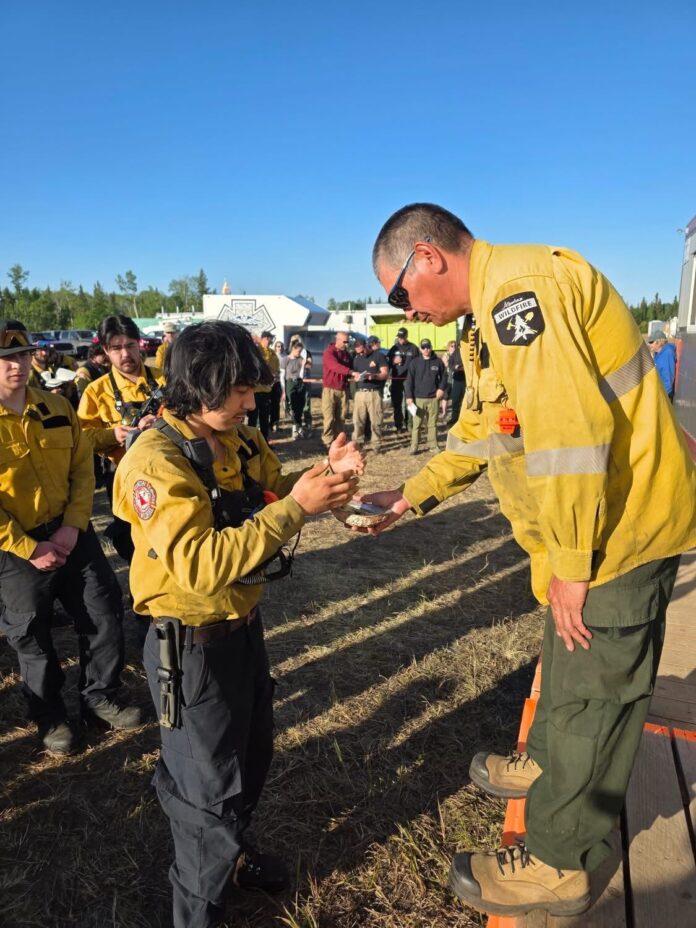“Today’s weather continues to be warm and dry, with the potential for crossover conditions and instability. Crews are prepared for initial attack response to any new starts near the fire, anticipating rapid spread with ignition,” said NWT Fire this afternoon.
Officials reported that three lightning-caused fires have broken out in the territories, but theTulip Lake wildfire is now 65 per cent contained.
No person-caused fires took place over the weekend, but officials urge the public to be cautious as a fire weather warning persists across the region.
Firefighters said that wildfires in the N.W.T. do not pose any danger to the public or to structures at this time.
Yesterday, Fire crews reported minimal fire activity, despite extreme fire weather conditions.
In the South Slave region near the Alta. border, with the progress on the western edges of the Tulip Lake wildfire increased to 65 per cent containment, officials said they are focusing their efforts on the eastern edges.
“Crews continue to grid and monitor the western side of the fire but the focus of firefighting effort has transitioned to the eastern flank of the fire. Firefighters have found some areas of heat and are working to extinguish them to secure the perimeter,” said NWT Fire.
The Tulip Lake wildfire continues to hold at about 14,167 hectares in size. The fire began on May 30, located about 5 km northeast of Fort Fitzgerald and 28 km east of Fort Smith. The wildfire is currently considered out of control and NWT firefighting crew are working in collaboration with First Nations, Wood Buffalo Fire and Atla. Fire.
Officials said the wildfire poses no risks to the community at this time.
“Firefighters continue to work mopping up the perimeter and monitoring for smoke and heat adjacent to the fire’s edge, extinguishing heat and flames within 30 meters of the perimeter,” NWT Fire reported.
Officials said a backhaul of firefighting equipment is being redeployed to other areas to respond to the wildfire.
Earlier this week NWT Fire said that the testing of the high-volume sprinkler system was successful and over 10 km of sprinkler systems were installed.
These were installed as a precaution to protect Fort Fitzgerald, Border Town, Halfway, and Fort Smith.
Fishing and recreating along the Slave River is still allowed alongside the high-volume sprinkler systems.
“Residents are asked not to interfere with the equipment located in the river and shoreline,” warned officials.
They said that while the systems are being tested or in use, conditions will be put in place to ensure public safety.
The dock at the boat launch is accessible for public use when high-pressure testing is not in operation, said officials.
A Wildfire Information Bulletin is available daily as this fire operation progresses. NWT asks anyone who would like more details to head to the webpage: https://www.gov.nt.ca/ecc/services/wildfire-update/en/fire/tulip-lake-fire
“Warmer weather along with the possibility of dry lightning, is expected to continue across most of the NWT in the coming days,” said officials.
NWT Fire cautioned the public to pay close attention to fire danger weather alerts and to avoid campfires if fire danger is high or extreme. They also urged the public to follow any fire bans in place.
Also in the South Slave region, another wildfire located about 13km west of Highway 1 in the Cameron Hills is monitored by Fire officials.
“This fire is burning near an area that burned in 2024, limiting its possibility for growth towards the highway. Crews will continue to monitor and deploy structure protection as required,” said fire crews.
This wildfire is 11,358 hectares in size and is considered out of control.
Officials cautioned that smoke may be visible on Highway 1 and urged the public to keep up-to-date on highway conditions at www.driventw.ca.
In the Sahtu region, two lightning-caused fires have broken out, including one located in the Tu’eyeta area, 92 km south of Fort Good Hope.
“This lightning-caused fire has been assessed to be approximately 39 hectares in size. There are currently no threats to communities, cabins, or infrastructure. This fire is currently being monitored,” said officials.
About 31 km northeast of Délı̨nę and 10 km west of Great Bear Lake, another lightning-caused fire, about 5 hectares in size, has broken out. Crews are actively responding to the fire.
“Tankers were dispatched to do drops to lessen fire activity and crews are on hand to work on this fire,” said NWT Fire.
Officials assured that the fire currently poses no threats to communities, cabins, or infrastructure. They said cabins in the area are being monitored and structure protection will be set up if needed.
“Residents should expect to see smoke due to winds from the north-northeast,” cautioned officials.
In the Dehcho region, a lightning-caused fire that is about 10 hectares in size broke out about 18 km northeast of Wrigley and 1 km north of Hodgson Creek. Crews are actively responding to the wildfire and warned of smoky conditions.
“Water drops took place over night and crews along with helicopters are enroute to further action this fire. There are currently no threats to communities, cabins, or infrastructure. Smoke plumes may be visible from Wrigley. Winds from the northwest will blow the fire to the southeast and not directly towards the community,” cautioned NWT Fire.
The Dehcho region’s smoke activity today is forecasted to continue into tomorrow.
Anyone who would like more information about air quality can head to the GNWT’s air quality site.
A smoke forecast map is available at www.firesmoke.ca
For more information about fire danger and to access the live fire map along with detailed updates, head to www.nwtfire.com.





